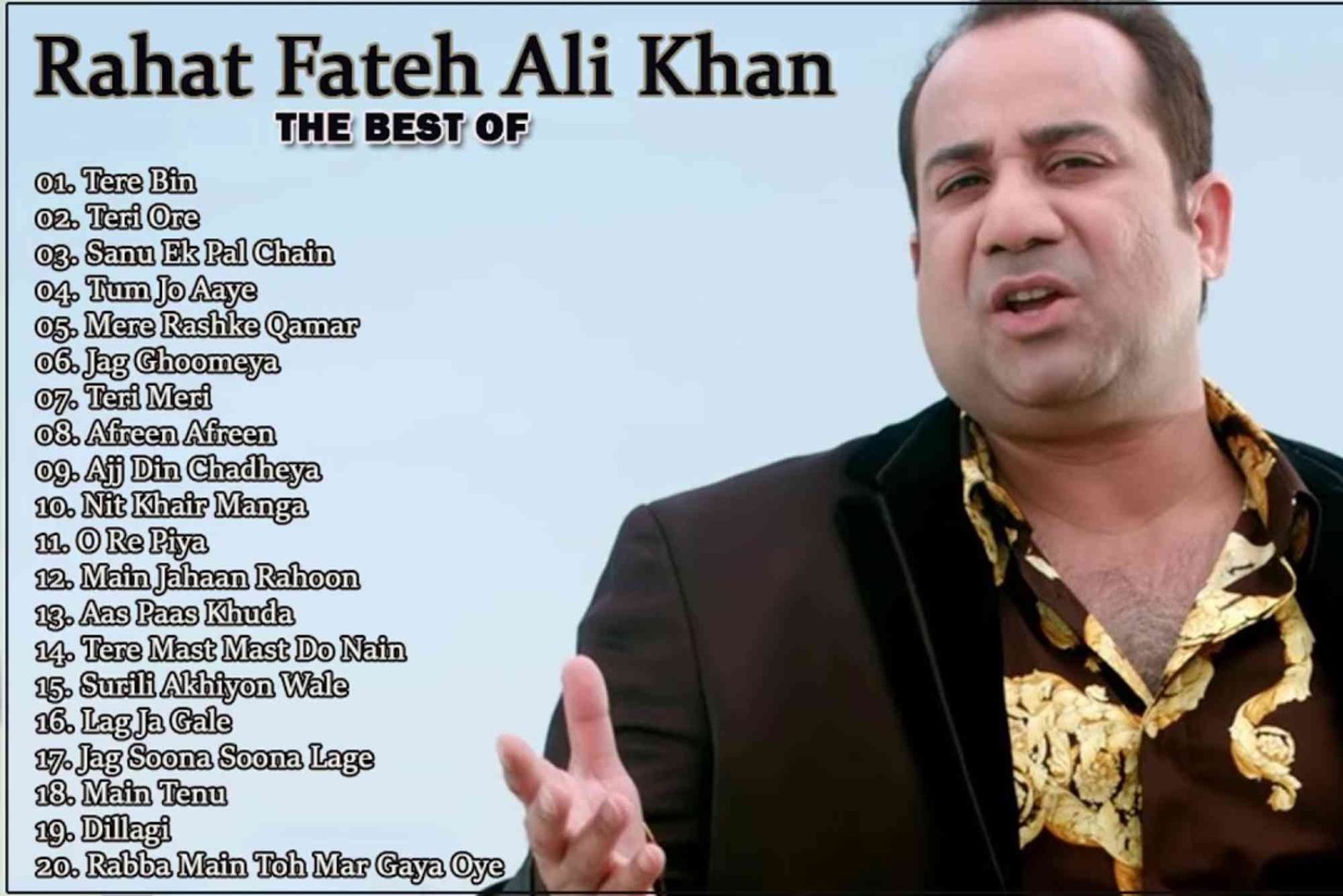Introduction
Few voices in the world have the power to touch the soul like that of Rahat Fateh Ali Khan. His music blends spirituality, love, and emotion into a timeless experience that transcends cultures. Whether you’re a music lover, a budding singer, or someone seeking inspiration from his artistry, exploring Rahat Fateh Ali Khan songs opens a door to musical excellence rooted in heritage and emotion.
The Legacy of Rahat Fateh Ali Khan
Rahat Fateh Ali Khan, the nephew of the legendary Ustad Nusrat Fateh Ali Khan, inherited a golden legacy of Sufi and Qawwali music. From an early age, he trained in classical music under the guidance of his uncle, mastering ragas, sur, and taal. His journey from traditional Qawwali gatherings to international fame showcases a unique fusion of cultural richness and modern expression.
Over the decades, Rahat Fateh Ali Khan has become synonymous with soulful vocals and heartfelt compositions. His songs cross borders, languages, and emotions, making him one of South Asia’s most admired artists. From Bollywood chartbusters to Coke Studio performances, his voice continues to inspire millions.
Understanding the Essence of Rahat Fateh Ali Khan Songs
The Power of Emotion in His Music
Every Rahat Fateh Ali Khan song carries deep emotion—whether it’s love, loss, devotion, or joy. His control over vocal expression allows him to convey feelings that words alone cannot. When you listen to “O Re Piya,” “Mann Ki Lagan,” or “Afreen Afreen,” you sense the purity and intensity of his emotions. This emotional depth is what makes his music timeless.
The Balance Between Classical and Contemporary
Rahat Fateh Ali Khan effortlessly bridges the gap between traditional Sufi music and modern melodies. His ability to adapt classical ragas into contemporary arrangements makes his songs accessible to a global audience. This balance between heritage and innovation is a hallmark of his artistry.
The Influence of Sufism
Much of Rahat’s music draws inspiration from Sufi philosophy—the pursuit of divine love and connection. Through his performances, he channels a spiritual energy that uplifts the listener. His renditions often remind us that music can be both a form of worship and an emotional release.
Practical Tips for Appreciating Rahat Fateh Ali Khan’s Songs
Listen Beyond the Lyrics
To truly understand Rahat Fateh Ali Khan’s music, listen beyond the words. Focus on the emotion in his voice, the subtle variations in tone, and the rhythm of his delivery. Each note tells a story of its own. Try listening to his unplugged performances where the purity of his voice shines even more.
Explore His Classical Roots
Understanding the classical foundation of his singing helps you appreciate his control and mastery. Learn about basic ragas like Yaman or Bhairavi—often used in his songs. This knowledge deepens your connection to his craft and helps you notice the nuances that make his music exceptional.
Create a Thematic Playlist
Organize Rahat Fateh Ali Khan songs into playlists based on mood—romantic, spiritual, or soulful. Songs like “Jag Soona Soona Lage” fit beautifully in a romantic playlist, while “Tajdar-e-Haram” resonates in moments of devotion. Curating playlists helps you experience his versatility across genres.
Observe His Live Performances
Watching his live performances on YouTube or music platforms gives you insights into his stage presence and vocal strength. Rahat’s ability to maintain perfect pitch and emotion in live shows reflects his deep professionalism and dedication to his art.
Focus on Collaboration and Evolution
Rahat Fateh Ali Khan has collaborated with music directors and singers across the world. Notice how he adapts his singing style in each collaboration—from Bollywood tracks like “Tere Mast Mast Do Nain” to international pieces like “Zaroori Tha.” His flexibility teaches artists the importance of growth and openness in music.
Expert Advice for Singers Inspired by Rahat Fateh Ali Khan
Train Your Voice in Classical Music
Rahat’s foundation lies in rigorous classical training. If you aspire to sing like him, dedicate time to learning the basics of sur, taal, and raag. Practice breathing exercises and control techniques to strengthen your voice and improve stamina.
Master Emotional Expression
Technical skill alone isn’t enough. Rahat’s greatest strength is emotional authenticity. When you sing, connect with the feeling behind the lyrics. Sing from the heart, not just the throat. This emotional connection helps your audience feel every note.
Prioritize Clarity and Control
Notice how Rahat articulates every word clearly without losing melody. Practice slow-paced singing to focus on clarity. Once you master control, gradually increase speed and complexity. This will improve both your diction and musicality.
Study His Transitions and Breathwork
Rahat’s transitions between notes and his breath control are exceptional. He can hold long phrases effortlessly while maintaining tone. Practice pranayama and controlled breathing techniques to improve your endurance and maintain stability while singing.
Embrace Cultural and Spiritual Depth
Music is not only about entertainment—it’s also a medium of expression and connection. Rahat’s songs reflect deep spirituality and respect for tradition. As a singer, explore your own cultural and emotional roots. Authenticity is what transforms good singing into great art.
The Global Impact of Rahat Fateh Ali Khan
Rahat Fateh Ali Khan’s music has reached audiences far beyond South Asia. His collaborations with Hollywood and international platforms, including the UN Concert for Peace, have earned him global admiration. His contribution to films like My Name Is Khan and Singham introduced millions to the beauty of Sufi-inspired music.
He has performed in sold-out concerts across the UK, USA, and the Middle East, where fans from diverse cultures come together to experience his music. The emotional universality of his voice proves that true art transcends borders.
The Evolution of Rahat’s Style
Over the years, Rahat Fateh Ali Khan has evolved from a traditional Qawwal to a versatile global artist. Early in his career, his focus was primarily on Sufi Qawwalis, but with time he ventured into playback singing and modern compositions. Despite these shifts, his essence remains deeply rooted in tradition.
Songs like “O Re Piya” showcase his romantic side, while “Tajdar-e-Haram” reflects his spiritual depth. His adaptability to various genres—romance, devotion, patriotism, and melancholy—makes him a rare gem in the world of music.
Why Rahat Fateh Ali Khan’s Songs Remain Timeless
The magic of Rahat Fateh Ali Khan songs lies in their universality. They speak to the soul regardless of language or culture. His voice has the rare quality of evoking nostalgia and comfort at once. His music brings together the old and the new, the classical and the contemporary, the divine and the human.
For many listeners, his songs are not just melodies—they are memories, prayers, and emotional journeys. Whether you play his music during celebrations or quiet reflections, it always resonates deeply.
Rahat Fateh Ali Khan’s music is a timeless reminder that true art speaks to the soul. His songs blend passion, faith, and melody into experiences that linger long after the music stops. Whether you’re learning, listening, or simply admiring, there’s always something new to discover in his work.
As you explore the enchanting world of Rahat Fateh Ali and his musical journey, remember that every note tells a story of devotion and emotion. To dive deeper into his legacy and find more expert insights, visit Rahat Fateh Ali Khan and continue exploring his artistry. For the latest music updates and news, you can also Read more on www.billboard.com and stay connected to the heartbeat of global music.
FAQs
What are some of Rahat Fateh Ali Khan’s most famous songs?
Some of his most beloved tracks include “O Re Piya,” “Tere Mast Mast Do Nain,” “Mann Ki Lagan,” “Afreen Afreen,” and “Tajdar-e-Haram.” Each reflects a different side of his vocal range and emotion.
What makes Rahat Fateh Ali Khan’s voice unique?
His voice carries both power and tenderness. His ability to balance classical precision with emotional warmth makes his singing unforgettable.
How can I learn to sing like Rahat Fateh Ali Khan?
Begin with classical training and focus on breath control, clarity, and emotional expression. Study his live performances for inspiration and technique.
Is Rahat Fateh Ali Khan still performing internationally?
Yes, Rahat continues to perform at major venues worldwide. His global fan base remains strong, and he frequently collaborates with international artists.
What is the difference between Nusrat and Rahat’s singing style?
While Nusrat Fateh Ali Khan was primarily focused on traditional Qawwali, Rahat expanded into Bollywood and global music, blending classical roots with modern sounds.















